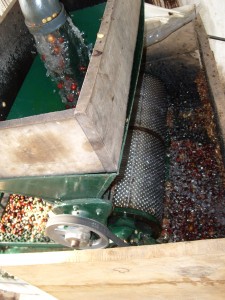Water Usage in the Café, at the Farm, and in the Future: Episode 2 – The Farm
By David Fasman, BGA Membership Committee
 It can take a huge amount of water to farm and process coffee…and most of the time it does. Central America is currently facing a crisis with water usage and contamination in coffee growing regions. Water usage at farm level is problematic. A single container of washed coffee (about 18 tons), processed in a traditional (older wet mill) method, requires more than a quarter of a million gallons of water from seed to container.[1] On top of usage, the wastewater from coffee mills and watershed runoff is substantially damaging the ecosystems at farm level as well as down stream. There are two primary problems with wastewater: first, the nutrient and pesticide contaminated water runs off into nearby streams and damages the biological ecosystems including plants and animals and second, the humans that live downstream from the farm are subjected to contaminated water and may be forced to drink unsafe water.
It can take a huge amount of water to farm and process coffee…and most of the time it does. Central America is currently facing a crisis with water usage and contamination in coffee growing regions. Water usage at farm level is problematic. A single container of washed coffee (about 18 tons), processed in a traditional (older wet mill) method, requires more than a quarter of a million gallons of water from seed to container.[1] On top of usage, the wastewater from coffee mills and watershed runoff is substantially damaging the ecosystems at farm level as well as down stream. There are two primary problems with wastewater: first, the nutrient and pesticide contaminated water runs off into nearby streams and damages the biological ecosystems including plants and animals and second, the humans that live downstream from the farm are subjected to contaminated water and may be forced to drink unsafe water.
Let’s look at processing first. Using old style wet mills, processing can take up to 60 liters per pound of dry parchment. “That number translates to over a million gallons of water within a growing season for even a small mill.”[2] That is a lot of water, and it can be easily reduced through the use of mechanical demucilagers to just under 11 liters per pound.[3] But why is the de-pulping of organic material so damaging? Even if the coffee is grown organically (without the use of any synthetic chemical fertilizers or pesticides) the resulting water is considered contaminated and here is why. “Wastewater created by washing the mucilage from coffee cherries contains a long list of substances: carbohydrates, proteins, fibers, fat, caffeine, polyphenols, and pectins, nitrates, ammonium, tannic acids, high levels of organic matter and very low dissolved oxygen levels.”[4] There are a host of problems that these substances can cause: all the way from algae blooms resulting in eutrophication, (the enrichment of an ecosystem with chemical nutrients, typically compounds containing nitrogen, phosphorus, or both), to biological oxygen demand in local water systems resulting in anaerobic water and the potential destruction of marine life.
Let me be clear, this isn’t to say stop producing coffee, because that would honestly be far more damaging to Central America. We just need to understand that what we do to water affects far more than the plants growing. In fact, in Central America alone, nine million people rely on water that comes from coffee growing regions.[5] Our job as educators, roasters, and retailers is to support change in these regions that promotes less invasive systems of growth and processing. As an industry we should be focusing on assisting with the instillation of mechanical demucilagers, supporting less water intensive processing techniques, teaching producers to not deforest entire landscapes and instead grow amongst trees that support healthy soil, and assist communities in water purification whose water source has been affected by coffee wastewater.
With all of this discussion of water, it is important to note the medium through which it runs – soil. Soil degradation is a major problem in coffee growing regions. This is due to several factors. The replacement of trees with coffee shrubs is a shock to the ecosystems of coffee growing regions. The total removal of trees and replacement with coffee shrubs leads to soil that lacks nutrients and beneficial bacteria, and is “dusty” and unstable.
“Farmers in the coffeelands are suffering their own Dust Bowl, but their soils are washing out to sea rather than blowing across the prairies. Coffee farms are less productive than they should be because soils are so degraded, and plants are far more susceptible to disease and drought precisely because soils lack the nutrients and moisture to stay healthy. At a landscape level, degraded soils lead to flashfloods and landslides as the land and vegetation lose their capacity to capture and store water. As a result, rivers run dry out in the dry seasons.”[6]
Those flashfloods and landslides are not just dangerous in the coffee growing regions but also at the end of the streams and rivers that begin in coffee growing regions. This is because the rate of erosion increases drastically when forests are cut down and replaced with coffee shrubs. As the mountain sides erode, they load streams with more sediment than they can naturally handle, leading to all sorts of problems like flooding, loss of fish habitat, the rapid siltation of hydro-electric dams, and the destruction of fresh water sources for communities at the end of the streams and rivers.
This article is not intended to be comprehensive. In all honesty, this is just barely a primer on the subject of water usage at farm level. Entire books could be written on the crisis that exists around water usage at coffee farms. Nonetheless, this subject is extremely important to our industry as a whole, and one that I wanted to help shed some light on for people who have not began to consider the water crisis that exists in coffee growing regions.
To end on a positive note, this is not an unknown crisis. There are several agencies assisting coffee farms with the instillation of mechanical demucilagers, helping reforest growing areas, recycling water and coffee cherry pulp, and helping protect potable water supplies for communities that rely on water from coffee growing regions. Our job as baristas and educators is to help educate the public, and even more importantly, our companies, on the importance of incentivizing producers to utilize methods that conserve water.
David Fasman is the Regional Training Manager at Kaldi's Coffee. He is a SCAA certified instructor and level 2 barista. He is a 3 time USBC competitor and active member of the barista guild. He serves on the membership committee and is the author of seedtocupcoffee.wordpress.com.
[1] Sheridan, M. (2012, August 13). Coffee and Water Resources at Origin. Retrieved December 9, 2015. [2] Kubota, L. (2013, July 8). Beyond the Quality of the Water in Your Cup. Retrieved December 9, 2015. [3] Kubota, L. (2013, July 8). Beyond the Quality of the Water in Your Cup. Retrieved December 9, 2015. [4] Kubota, L. (2013, July 8). Beyond the Quality of the Water in Your Cup. Retrieved December 9, 2015. [5] Hicks, P. (2015, April 17). We All Drink Downstream. Retrieved December 9, 2015. [6] Hicks, P. (2015, April 17). We All Drink Downstream. Retrieved December 9, 2015.
